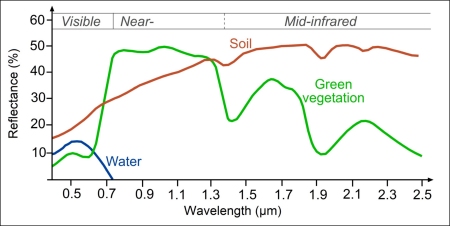The Light Spectrum or why does Remote Sensing work?
For an understanding of why multispectral remote sensing works, it is a good idea to recap some physics (mainly optics) and how light and color work.
Light, Color and Wavelengths


First of all we regard light as a wave with a certain wavelength. Different wavelengths of light appear to humans as different colors because we have three different cone cells in the eye which are sensitive to different wavelengths. Thus, wavelengths appear to us as red, green and blue. All other colors are a mixture of these three primary colors.
Although sunlight appears white for a human observer, it consists of a multitude of different wavelengths. Objects appear colorful to us because they absorb and reflect certain wavelengths to a different extent. Multispectral remote sensing makes use of this fact by relating the reflectance information to different features of the landscape.


